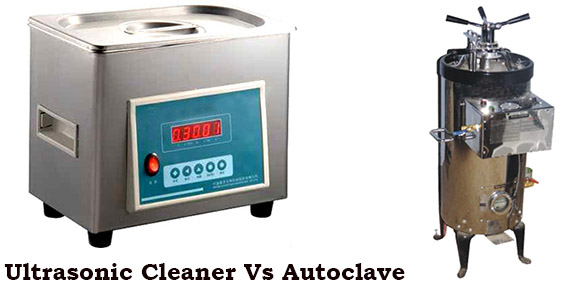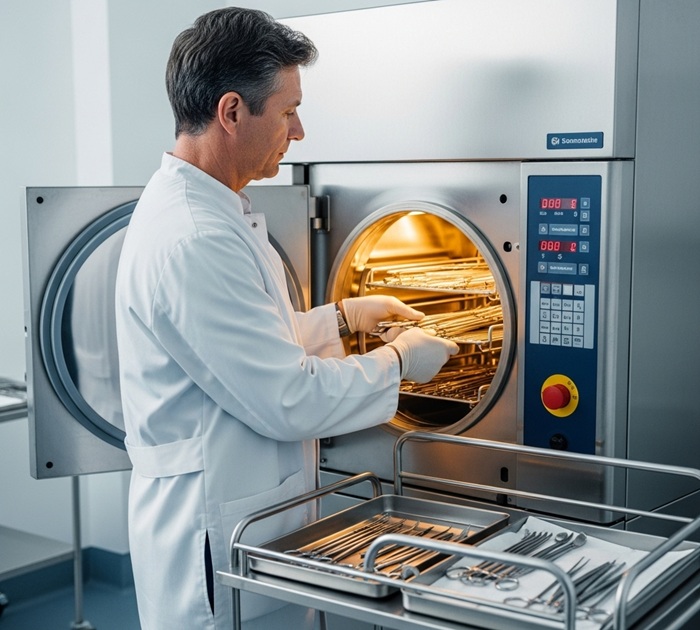
The basic difference between an autoclave and an ultrasonic cleaner is that an autoclave makes use of high temperatures and steam to clean and remove bacteria, viruses, or germs.
On the other hand, ultrasonic cleaning devices utilize high-frequency sound waves to perform tough cleaning tasks. As the process is performed using high-frequency electrical energy, it presents the ability to clean the tenacious material from the core units.
Professionals sometimes recommend using ultrasonic cleaners first to clean and then autoclaving to sterilize the same item. Both serve critical roles, especially in environments where hygiene and safety are non-negotiable.
Used together, they provide a comprehensive solution for instrument maintenance.
Ultrasonic Cleaner: Deep Cleaning Through Cavitation
Operating at frequencies typically between 20–40 kHz, ultrasonic cleaners produce microscopic bubbles through a phenomenon called cavitation.
These tiny bubbles collapse with incredible energy, creating a powerful scrubbing action that reaches into the tiniest crevices, removing stubborn contaminants like grease, dust, and organic residue.
Whether you’re cleaning delicate jewelry, instruments, or intricately designed tools, ultrasonic technology ensures every surface is meticulously cleaned without physical abrasion.
Ideal as a pre-sterilization step, ultrasonic cleaners are a game-changer for precision cleaning.
While they don’t kill bacteria or viruses, they eliminate even the most stubborn debris from hard-to-reach areas—something manual cleaning simply can’t match.
If you demand thoroughness, efficiency, and care for your delicate instruments, ultrasonic cleaning is not just an option—it’s the standard you can trust.

Autoclave: Sterilization Through Steam and High Pressure
Autoclaves utilize high-pressure steam at temperatures ranging from 121°C to 134°C to eliminate all forms of microbial life, including the most resilient bacterial spores.
This powerful combination of heat and pressure guarantees a level of sterilization that no chemical or dry heat method can rival, making it essential for environments where safety and hygiene are non-negotiable.
Whether it’s surgical tools, laboratory glassware, or any equipment requiring thorough sterilization, the autoclave delivers consistent, reliable results.
However, to achieve its full effectiveness, items must first be meticulously cleaned—organic matter can compromise the process.
When you demand complete microbial elimination, trust the science of steam and pressure to safeguard your instruments and your standards.
Ultrasonic Cleaner vs. Autoclave – Which is Better to Use and When?
Choosing between an ultrasonic cleaner and an autoclave depends entirely on the intended use—cleaning versus sterilization.
For household applications and regular cleaning of objects, the ultrasonic cleaner is highly effective.
It uses high-frequency sound waves to dislodge dirt and grime from intricate surfaces—ideal for items like jewelry, glasses, and grooming tools. Its simplicity, safety, and affordability make it well-suited for everyday, non-specialist use.
In contrast, when it comes to medical use and sterilization, which requires a higher standard, autoclaves deliver complete sterilization through pressurized steam at elevated temperatures, eliminating all microbial life, including resistant spores.
This level of decontamination is essential in clinical environments where safety is non-negotiable.
In summary: use ultrasonic cleaners when thorough, non-destructive cleaning is needed; rely on autoclaves when sterilization is critical.
